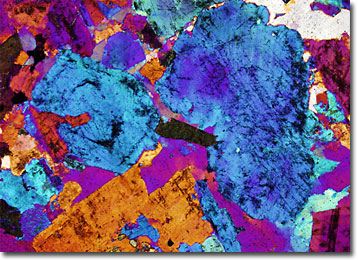Polarized Light Microscopy Digital Image Gallery
Granodiorite
The medium- to coarse-grained rock known as granodiorite occurs worldwide, but is particularly abundant in North America, Scandinavia, and Brazil. It is sometimes described as having a “salt and pepper” appearance and was a popular material for sculptures in ancient Egypt.

An intrusive igneous rock, granodiorite often forms large masses in the roots of mountain ranges, such as the Andes. It also often occurs in association with granitic batholiths. Indeed, granodiorite is often confused with granite, a rock with which it shares a similar appearance, texture, and composition. Granodiorite does, however, typically appear somewhat darker than granite because it contains a greater amount of plagioclase feldspar. Other mineral components of granodiorite include quartz, orthoclase feldspar, and, to a lesser extent, hornblende, biotite, apatite, and sphene. The presence of quartz is what differentiates granodiorite from the closely related rock diorite. In polished form granodiorite is still occasionally utilized as an ornamental stone, but has also found use as an aggregate material for roadways.
